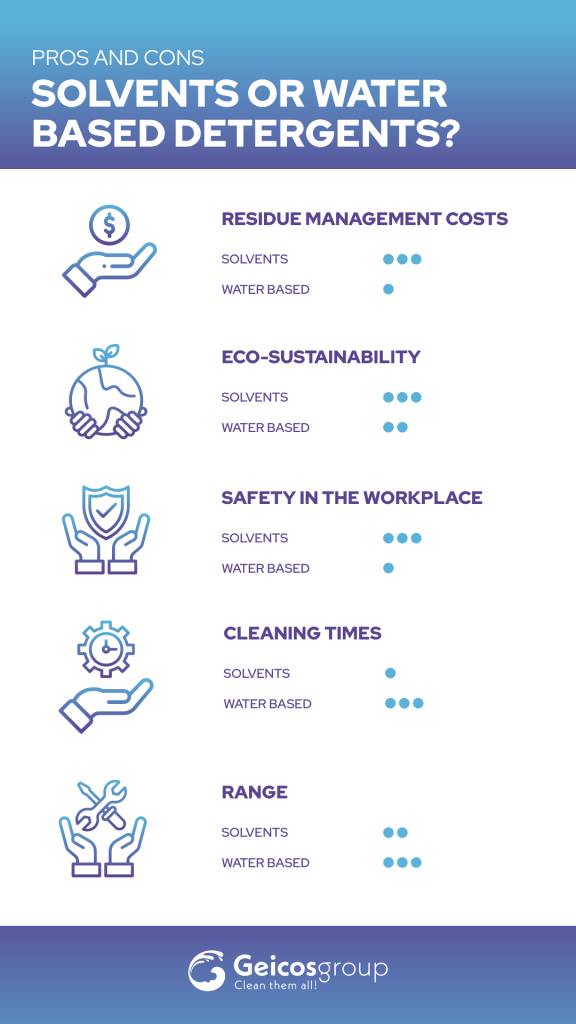
Industrial washing products: solvent vs water
When asked about the type of detergent to be used for cleaning, GEICOS recommends choosing a specific solution based on the challenge that must be faced. The use of the right detergent during the cleaning process is essential not only for the expected result, but also for the correct maintenance of the equipment used.
Table of contents
1. Which product to choose?
One of the most frequently asked questions during consultations is: is a water-based or solvent-based cleaner better?
As you can guess, the answer is not unique, but it depends on the type of application we have to face; and since each production process is unique and specific, there cannot be a solution suitable for everything.
On the other hand, what remains constant is the result you want to obtain: a thorough cleaning of the parts and equipment. These, according to individual needs, must not have halos, dust, grease, oils, and so on.
Both detergent products, solvent or water-based, aim for the same result: the difference lies in the needs of the company. The solution to be adopted varies according to the single production process, which is unique, and the consequent choice of which product to use is the result of a specific need and a specific company philosophy.
The factors that influence the use of one product rather than the other are many, let’s analyze them specifically
1- How the product is managed: certain substances may require specific organizational and corporate compliance requirements such as for example authorization aspects and compliance with current regulations, maintenance of any requirements, etc.
2- Cleaning times: as you will see below, the choice of a specific product has repercussions on the time to devote to the cleaning phases;
3- Residue management costs: based on the type of detergent chosen, there may be considerable variations in terms of disposal costs;
4- Storage: with reference to the mandatory rules on emergency management and fire prevention, it will be necessary to evaluate a suitable warehouse storage and inventory management system;
5- Safety in the workplace: this is a factor that directly impacts on organizational aspects as regards collective and individual protective equipment and related investments;
6- Eco-sustainability of the product: fundamental value for the image and company philosophy, the commitment to the use of eco-friendly substances can significantly affect the decision-making choice towards a cleaning product rather than another.
Therefore, starting from these assumptions, let’s see the characteristics of the two types of detergent in terms of advantages and disadvantages.
2. Chemical solvent based cleaners
Solvents are commonly identified as liquid products that dissolve one or more substances (whether solid, liquid or gaseous). The solvent has been for many years the cleaning product par excellence, as it guarantees the result in a short time. In some cases, it is not even necessary to add a physical force such as the brush or the action of the washing nozzles to the washing process. On the other hand, since it is a high-risk pollutant, choosing this product also means opting for a more expensive residual management, since it must be more prudent and meticulous.
Handling a solvent implies that the most important safety devices are present in the production process to safeguard the health of the worker, from simple PPE (personal protective equipment such as a mask, gloves and goggles) to the fumes extraction and purification system. So if the priority is to clean the piece in a short time and you have a good budget, then the choice will fall on the solvent.
3. Water based cleaners
Water cleaners are non-flammable products, do not contain organic solvents and phosphates and are easily biodegradable. These products protect plastics, gaskets, rubber and sensitive metal surfaces; they are suitable for use with high pressure and high temperature cleaners.
By altering the pH of the aqueous solution, the cleaner can more effectively remove various substances. Acidic aqueous solutions are better for removing scale, rust and metal oxides, while alkaline aqueous solutions remove salts, oxides, organic dirt, metal shavings and grease.
Thanks to the use of water-based products, important sums of money can be saved in the management of the residue. In fact, in this sector, new technologies have made numerous eco-friendly and sustainable solutions available. On the other hand, if the company can opt for a slightly longer process for the cleaning process, then the water-based cleaner is the most congenial solution.
4. Solutions compared
When choosing a product rather than another, it is important to keep in mind all the advantages it offers, but also the burdens and weaknesses that it entails in the production process in a broad sense such as disposal costs, energy consumption and the like.
In this infographic we have highlighted the pros and cons for each type of detergent. You will need to get an idea of which product is most suitable for your specific situation.

In conclusion, we have seen how the choice of the right detergent varies according to each specific need. Both products, chemical solvent based cleaners and water based cleaners, are viable solutions and each has its own strengths and weaknesses. It will therefore be up to the company to decide which behavior to adopt in accordance with both its corporate philosophy and the logistical-organizational aspects.
Every company has an objective and incontrovertible need and, for us at Geicos, this need translates into a goal to be achieved in a resolute and optimal way, even starting from the most basic tips such as choosing the right detergent. Detergents are an essential product in the process for cleaning the piece and are essential for obtaining a good result.